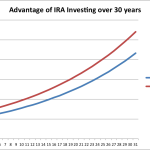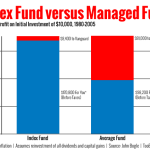My family dodged a major financial catastrophe this Spring.
I have one large point to make about the difficulty of making optimal personal finance choices within one’s own family. In the telling of the story, I slip in some small points about paying for college and updates to 529 education savings accounts.
This story ends well, but for a while it looked like we were totally cooked, financially.
Pursuing one’s dream
In November 2021 we did an official campus tour of highly selective out-of-state private University A. Old buildings, beautiful weather. Incredible foliage. Everything you’d want based on the brochures. My daughter, early in her high school career then, fell in love. I think it was the foliage. University A became her top choice from then on.
You might think allowing her first to fall in love with, and then second to apply to, a private out-of-state university was the original sin we committed. You wouldn’t be wrong. On the other hand, she has told us for at least the past four years that going to college out of state was a primary criterion. We respected that. Also in our defense we had not been totally irresponsible with funding her 529 account, which we started when she was 1.5 years old. The account had grown to something substantial.

Unfortunately, the sticker price of higher education for private universities has also grown, but to absurd heights, over the last 20 years. What normal family can afford this? If you haven’t checked lately, the all-in cost (tuition, room & board, books, fees, insurance and transportation) is about $90 thousand per year. Multiplying that by 4 years gets you to $360 thousand for an undergraduate degree. What even? Huh?
Briefly about 529 Accounts
529 accounts are merely fine investment vehicles. They are better than nothing. They are inferior to retirement accounts like 401Ks or IRAs.
I advise parents who have to choose which bucket to place their scarce investment dollars to fund their own retirement accounts more generously than their child’s 529 account. The tax advantages, opportunity for employer-matching, and long-term growth are all superior in retirement accounts as compared to a 529 account.
Another long-time knock on – or at least fear about – 529 accounts was that overfunding these accounts could leave dollars stranded, unusable for education purposes. I know that’s possible because two different families I am close to – relatives of mine – have overfunded their kids’ 529 accounts.
A 2024 change in 529 rules has made these accounts somewhat better and reduced the risk of “stranded money.” I’ll describe the rule change below.
But first, back to my daughter’s college journey.
She received a number of college acceptances this Spring, including her dream school, University A. Yay!
Because of its prestige, it has a policy of not offering merit scholarships. This is typical of highly selective universities in which the admission office essentially says “all of our accepted students have extraordinary merit,” so nobody gets money on that basis. Boo!

She also got into University B with a very generous merit scholarship. For social and sporting reasons she also strongly considered University C, which offered a decent scholarship. In April of this year she had narrowed down her choice to A, B, or C. All three out of state, and private. The sticker prices for each is wildly high, but because of the three different merit scholarships, A, B, and C had totally different actual costs for our family.
The difference between finance rules and real life
With my finance-guy hat on, I know the cost of private out of state college is utterly ridiculous. Unconscionable. Absurd. Specifically, University A would cost us more than twice the amount that we had saved up over 17 years.

But I am not only a finance guy. I am also a dad and a husband. And something strange happens when you try to apply finance-guy rules to real life choices for people who you love more than anything in the world. The rules melt away in the face of your most precious relationships.
[A reader recently wrote in to chastise me for making certain choices with respect to home equity line of credit debt, which isn’t in line with theoretical best practices. That’s right, I have done that. I will continue to deviate from best practices at times. Other criteria are sometimes preferable to the finance theory.
I know deep in my bones the personal finance rule that for a student – and her parents – going into extraordinary debt for undergraduate education is not a wise idea. And yet, when it came to the moment for my daughter to decide on college before May 1st, 2024, we did not insist on her choosing the optimal financial strategy.
We said she could choose University A.
My wife and I were those parents who did not enforce the right thing financially. Because of the crazy cost of private higher education, we faced taking on six-figure debt to make her dream come true. To paint a slightly fuller picture of the University A scenario, we also would have required our daughter to borrow the full amount of Federal unsubsidized loans under her own name, which adds up to $27,000 over four years. Which is also not optimal.
Financially, this was nuts. Emotionally, however, we were not willing to deny her a chance to pursue her dream.
The new 529 to Roth IRA rules
As I promised, I also have a small point to make about paying for education. That is, while 529 accounts aren’t amazing, they just got incrementally more flexible in 2024. That’s a good thing. Beginning in 2024, surplus funds – by which I mean money in a 529 account that will not ultimately be spent on the beneficiary’s education – can now be repurposed in a very advantageous way.

Surplus 529 account funds can be contributed to a beneficiary’s Roth IRA, with certain restrictions in the fine print, as follows.
First, the 529 account must have been open for a minimum of 15 years. Next, the lifetime limit for moving surplus 529 funds to a Roth IRA is $35,000. At the current annual individual contribution limit of $7,000, it would take at least 5 years to max out this 529 to Roth IRA conversion opportunity. In addition, the IRA beneficiary must have earned at least the contributed amount of income in the year it was contributed. So for example, a student earning $3,000 in income during a calendar year could only contribute up to $3,000 to her IRA that year. Finally, funds in the 529 have to have been in the account for more than 5 years before turning them over to the beneficiary’s Roth IRA.
These are a lot of conditions to satisfy. The purpose of all these persnickety rules is to make sure the 529 account is not being used as a backdoor Roth IRA funding loophole.
This 529 to Roth IRA rule is available this year for the first time in 2024.
Which is very very good! Because we got lucky and our daughter decided to give up her dream of University A in favor of University B. With University B, because of their generous merit scholarship, we will have funds left over in her 529 account at the end of 4 years.
In my family’s particular case, we satisfy all the persnickety conditions, so we are eligible to help fund our daughter’s Roth IRA, up to $35 thousand dollars, in her early working years.
This is all subject to change if she chooses instead to go to graduate school or some other educational opportunity that is more attractive than funding her Roth IRA. She starts University B in a few weeks. Hopefully she’ll have a Roth IRA funded after her first 5 working years as well. We got lucky and it was a very close thing.
A version of this post ran in the San Antonio Express News and Houston Chronicle
Post read (124) times.






 A version of this post ran in the
A version of this post ran in the 









